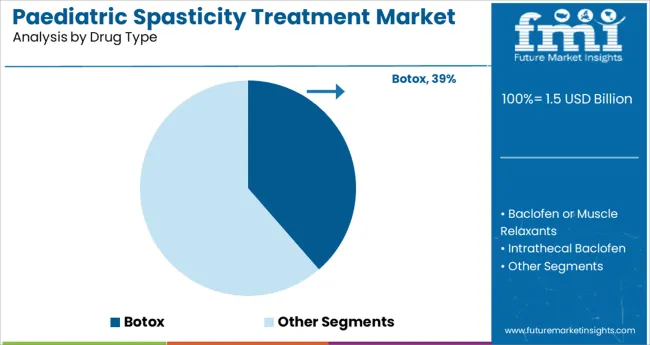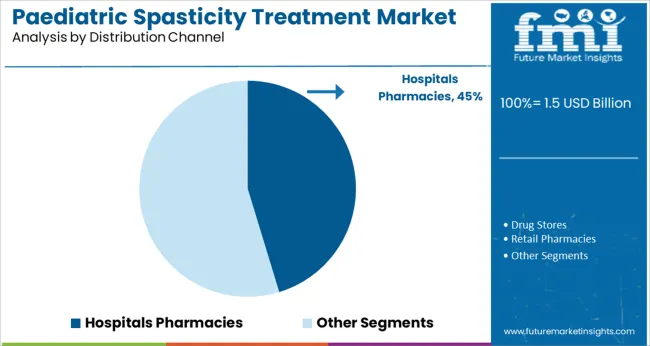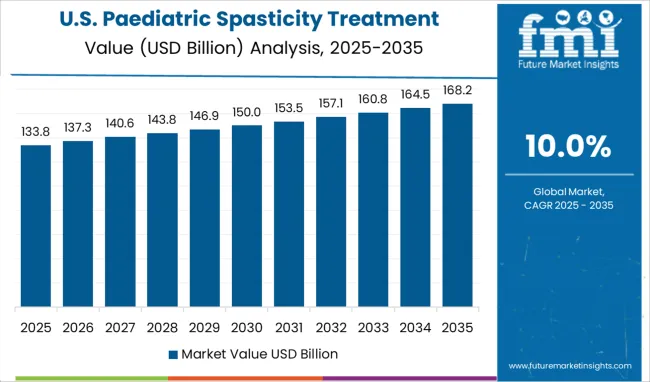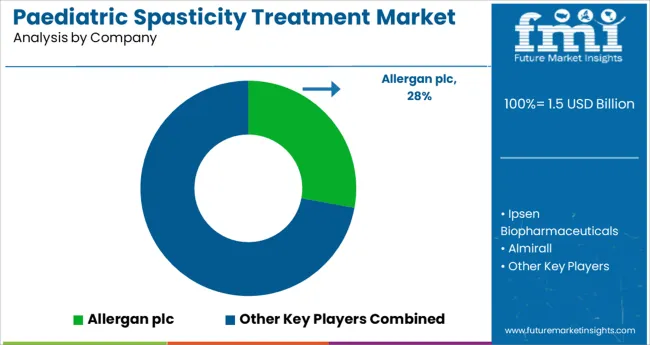The Paediatric Spasticity Treatment Market is estimated to be valued at USD 1.5 billion in 2025 and is projected to reach USD 3.8 billion by 2035, registering a compound annual growth rate (CAGR) of 10.0% over the forecast period.

The paediatric spasticity treatment market is experiencing steady expansion as clinical understanding of childhood neuromuscular disorders evolves and treatment protocols advance. There has been growing attention from healthcare professionals on managing spasticity to improve mobility and prevent long-term complications in children with cerebral palsy and other neurological disorders. Scientific publications have emphasized the importance of early therapeutic intervention to minimize musculoskeletal deformities and enhance quality of life.
Drug development in this space has focused on formulations tailored for paediatric patients with a strong emphasis on safety and tolerability. Additionally, healthcare systems have expanded specialized rehabilitation and neurology care services which has increased treatment accessibility.
Looking ahead, the market is expected to grow with advancements in therapeutic techniques and a rising focus on multidisciplinary care models. Segmental growth is anticipated to be led by Botox in drug type, Injectable as the preferred route of administration, and Hospitals Pharmacies in the distribution channel reflecting clinical adoption patterns and patient care requirements.
The market is segmented by Drug Type, Route of Administration, and Distribution Channel and region. By Drug Type, the market is divided into Botox, Baclofen or Muscle Relaxants, Intrathecal Baclofen, Clonazepam, Diazepam, Tizanidine, and Others. In terms of Route of Administration, the market is classified into Injectable and Oral. Based on Distribution Channel, the market is segmented into Hospitals Pharmacies, Drug Stores, Retail Pharmacies, and Mail Order Pharmacies. Regionally, the market is classified into North America, Latin America, Western Europe, Eastern Europe, Balkan & Baltic Countries, Russia & Belarus, Central Asia, East Asia, South Asia & Pacific, and the Middle East & Africa.
The market is segmented by Drug Type, Route of Administration, and Distribution Channel and region. By Drug Type, the market is divided into Botox, Baclofen or Muscle Relaxants, Intrathecal Baclofen, Clonazepam, Diazepam, Tizanidine, and Others. In terms of Route of Administration, the market is classified into Injectable and Oral. Based on Distribution Channel, the market is segmented into Hospitals Pharmacies, Drug Stores, Retail Pharmacies, and Mail Order Pharmacies. Regionally, the market is classified into North America, Latin America, Western Europe, Eastern Europe, Balkan & Baltic Countries, Russia & Belarus, Central Asia, East Asia, South Asia & Pacific, and the Middle East & Africa.

The Botox segment is projected to account for 38.6% of the paediatric spasticity treatment market revenue in 2025 making it the leading drug type. This segment has been driven by the proven clinical effectiveness of botulinum toxin in reducing muscle tone and improving functional mobility in children with spasticity. Healthcare providers have selected Botox for its targeted action which allows localized muscle relaxation without systemic side effects.
Treatment guidelines have recommended botulinum toxin as a first-line intervention in managing focal spasticity supporting its adoption in clinical practice. Additionally, Botox injections have been associated with reduced surgical interventions and improved therapy outcomes when used alongside physiotherapy.
As clinical experience with paediatric dosing protocols grows the Botox segment is expected to remain the drug of choice for spasticity management in children.

The Injectable segment is projected to contribute 52.4% of the paediatric spasticity treatment market revenue in 2025 holding its leadership in route of administration. This segment has expanded due to the preference for targeted drug delivery methods that provide localized symptom relief with predictable effects. Injectable formulations such as botulinum toxin have allowed clinicians to deliver therapy directly to overactive muscles ensuring better control over treatment outcomes.
The rapid onset of action and extended duration of symptom relief have further supported the widespread use of injectables in paediatric spasticity care. Additionally, advancements in injection techniques and improved patient comfort measures have enhanced the acceptability of this route among children and caregivers.
As personalized treatment plans become more common the Injectable segment is expected to continue its growth as the preferred method of administration.

The Hospitals Pharmacies segment is projected to capture 45.3% of the paediatric spasticity treatment market revenue in 2025 maintaining its dominance among distribution channels. This segment has grown as specialized treatments like botulinum toxin injections are typically administered in hospital settings where multidisciplinary care teams oversee paediatric neurology and rehabilitation. Hospitals Pharmacies have served as the primary point for procuring and dispensing these therapies ensuring compliance with safety protocols and dosage requirements.
Additionally, hospitals have expanded paediatric specialty clinics and outpatient departments improving access to spasticity management services. The role of Hospitals Pharmacies has also included supporting patient education and follow-up care coordinating between physicians therapists and families.
With the ongoing focus on comprehensive paediatric care the Hospitals Pharmacies segment is expected to remain the key distribution channel for spasticity treatment medications.
Increasing awareness, growing research and development for drug development drive the sales of paediatric spasticity treatment in the near future. Changing lifestyle, developing new and innovative technology, and improving healthcare infrastructure are expected to fuel the demand for paediatric spasticity treatment in the forecast period.
The launch of novel therapeutics and growing per capita income in emerging economies such as China and Brazil is further driving the sales of paediatric spasticity treatment.
Some key factors that might hinder the growth of paediatric spasticity treatment market include the high cost of treatment and low awareness in underdeveloped and developing countries, and rigorous regulations for the approval of drug.
The progress and development of new therapeutic treatments, as well as the growing number of clinical trials for paediatric spasticity treatment, provide a significant opportunity for the demand for paediatric spasticity treatment to grow over the forecast period.
Collaboration and partnership among leading companies for the development of novel medications, as well as increased research funding, will boost the sales of paediatric spasticity treatment in the near future.

North America is expected to contribute to a major share in the global paediatric spasticity treatment market, owing to the increasing population, increasing number of screening procedures, presence of major manufacturers, and growing clinical trials.
Well-developed healthcare facilities and government funding for drug development further drive the sales of paediatric spasticity treatment.
Europe contributes the second-largest share with significant growth in the demand for paediatric spasticity treatment owing to technological advancement in the treatment coupled with growing adoption of a new treatments.
Asia Pacific paediatric spasticity treatment market is primarily driven by the factors such as growing prevalence, increasing population, and growing awareness of new treatment options.
China is expected to register rapid growth in the sales of paediatric spasticity treatment due to the large patient pool and availability of new drugs for the paediatric spasticity treatment.
Latin America and Middle East & Africa are projected to show a slow rise in demand for paediatric spasticity treatment due to less awareness, lack of adequate healthcare facilities, and less developed infrastructure.

Some of the key players present in the global paediatric spasticity treatment are Allergan plc, Ipsen Biopharmaceuticals, Inc., Almirall, S.A, Piramal Critical Care, Inc., Genentech, Inc, Sanofi, Saol Therapeutics, and US WorldMeds, LLC among others.
The demand for paediatric spasticity treatment is moderately competitive, with several significant players. In terms of sales of paediatric spasticity treatment, just a few of the market's top firms are currently producing new products to solve unmet market challenges.
Recent Developments in the paediatric spasticity treatment market include:
The US Food and Drug Administration (FDA) accepted a supplementary Biologics License Application for XEOMIN in August 2024. (incobotulinumtoxinA).
The United States Food and Drug Administration (FDA) approved the expanded use of Dysport (abobotulinumtoxinA) for the treatment of Spasticity in paediatric patients in July 2024, according to Ipsen Biopharmaceuticals.
The report consists of key players, contributing to the paediatric spasticity treatment market share. It also consists of organic and inorganic growth strategies adopted by market players to improve their market positions. This exclusive report analysis the competitive landscape and paediatric spasticity treatment market share acquired by players to strengthen their market position.
| Report Attribute | Details |
|---|---|
| Growth rate | CAGR of 10% from 2025 to 2035 |
| Base year for estimation | 2024 |
| Historical data | 2020 to 2024 |
| Forecast period | 2025 to 2035 |
| Quantitative units | Revenue in million, volume in kilotons, and CAGR from 2025 to 2035 |
| Report coverage | Revenue forecast, volume forecast, company ranking, competitive landscape, growth factors, and trends, Pricing Analysis |
| Segments covered | Drug type, route of administration, distribution channel, region |
| Regional scope | North America; Western Europe; Eastern Europe; Middle East; Africa; ASEAN; South Asia; Rest of Asia; Australia and New Zealand |
| Country scope | USA, Canada, Mexico, Germany, UK, France, Italy, Spain, Russia, Belgium, Poland, Czech Republic, China, India, Japan, Australia, Brazil, Argentina, Colombia, Saudi Arabia, UAE, Iran, South Africa |
| Key companies profiled | Allergan plc; Ipsen Biopharmaceuticals Inc.; Almirall; S.A; Piramal Critical Care, Inc.; Genentech Inc; Sanofi; Saol Therapeutics; USA WorldMeds, LLC among others. |
| Customization scope | Free report customization (equivalent to up to 8 analysts working days) with purchase. Addition or alteration to country, regional & segment scope. |
| Pricing and purchase options | Avail customized purchase options to meet your exact research needs. |
The global paediatric spasticity treatment market is estimated to be valued at USD 1.5 billion in 2025.
It is projected to reach USD 3.8 billion by 2035.
The market is expected to grow at a 10.0% CAGR between 2025 and 2035.
The key product types are botox, baclofen or muscle relaxants, intrathecal baclofen, clonazepam, diazepam, tizanidine and others.
injectable segment is expected to dominate with a 52.4% industry share in 2025.






Full Research Suite comprises of:
Market outlook & trends analysis
Interviews & case studies
Strategic recommendations
Vendor profiles & capabilities analysis
5-year forecasts
8 regions and 60+ country-level data splits
Market segment data splits
12 months of continuous data updates
DELIVERED AS:
PDF EXCEL ONLINE
Paediatric Oncology Therapeutics Market Size and Share Forecast Outlook 2025 to 2035
Paediatric Wheelchairs Market Size and Share Forecast Outlook 2025 to 2035
Paediatric Vaccine Market Size and Share Forecast Outlook 2025 to 2035
Paediatric Sports Medicine Market Size and Share Forecast Outlook 2025 to 2035
Paediatric & Neonatal Testing Kits Market – Growth & Forecast 2025 to 2035
Paediatric Respiratory Syncytial Virus Infection Market Growth - Trends & Forecast 2025 to 2035
Paediatric Respiratory Disease Therapeutics Market
Paediatric influenza treatment market Size and Share Forecast Outlook 2025 to 2035
Paediatric Neuropsychiatric Disorders Treatment Market
Spasticity Treatment Market Size and Share Forecast Outlook 2025 to 2035
Treatment-Resistant Hypertension Management Market Size and Share Forecast Outlook 2025 to 2035
Treatment-Resistant Depression Treatment Market Size and Share Forecast Outlook 2025 to 2035
Treatment Pumps Market Insights Growth & Demand Forecast 2025 to 2035
Pretreatment Coatings Market Size and Share Forecast Outlook 2025 to 2035
Air Treatment Ozone Generator Market Size and Share Forecast Outlook 2025 to 2035
CNS Treatment and Therapy Market Insights - Trends & Growth Forecast 2025 to 2035
Seed Treatment Materials Market Size and Share Forecast Outlook 2025 to 2035
Acne Treatment Solutions Market Size and Share Forecast Outlook 2025 to 2035
Scar Treatment Market Overview - Growth & Demand Forecast 2025 to 2035
Soil Treatment Chemicals Market

Thank you!
You will receive an email from our Business Development Manager. Please be sure to check your SPAM/JUNK folder too.
Chat With
MaRIA